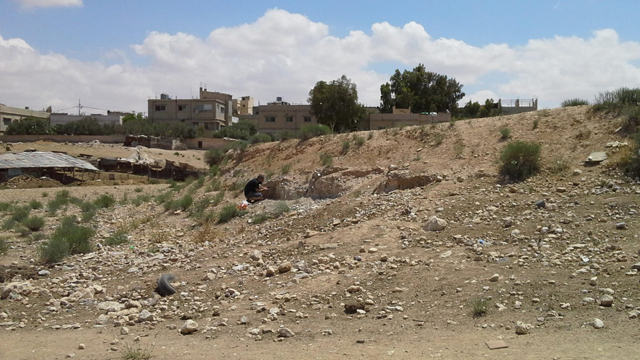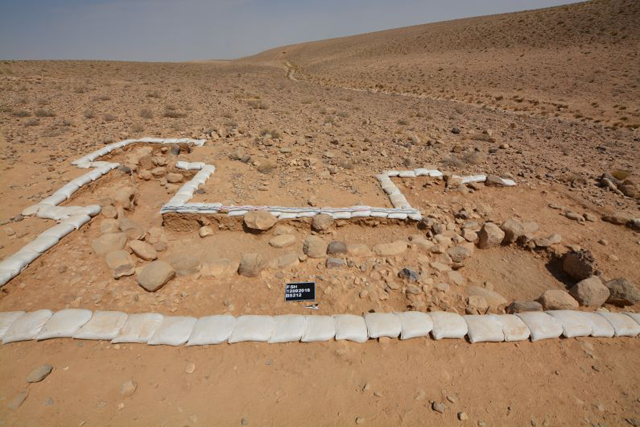You are here
Latest insights into Jordanian prehistory: Discoveries from the Dawqara Formation
By Saeb Rawashdeh - Nov 02,2024 - Last updated at Nov 02,2024

The Brazilian-Italian team of archaeologists study at Sukhna (Photo courtesy of the University of Parana)
AMMAN — At the confluence of the Zarqa and Dulayl rivers, north and west of the town of Sukhna, near Zarqa, many sections have been excavated by heavy machinery to enhance the agricultural capacity of irrigable fields on artificial terraces and thereby exposing the extraordinary Plio-Pleistocene archaeological record of the valley.
"The first notice of Palaeolithic artefact-bearing outcrops in the upper Zarqa Valley dates from the 1982 and 1983 survey campaigns led by Francis Hours and financed by the French ministry of foreign affairs," noted Fabio Parenti, adding that the French team proposed a detailed geo-morphological reconstruction of the valley both upstream and downstream of the confluence between Zarqa and Dulayl, along with a first description of the flake and core industry recovered from eight outcrops in the uppermost fluvial terrace, named since then the “Dawqara Formation or complex”.
Their model identified four artefact-bearing fluvial terraces and based on this model, a second research project on the Palaeolithic of the valley led by an Italo-Jordanian team surveyed a roughly 100 kilometres square-wide area to reassess the different archaeological periods.
"Between 1996 and 1999, more than 80 outcrops were mapped, some of them providing a rich assemblage of core sand flakes made on chert cobbles. The previously estimated chronology of the oldest material, based on geomorphology and the lithic typology, was of about half a million years," Parenti, adding that this proposition was based on the observation that the assemblage was essentially a core and flake industry, lacking symmetry, detailed planning, or a complex organisation off lacking sequences.
The third research project was conducted by Parenti's team between 2013 and 2016 and the study provided a more detailed stratigraphic framework for the oldest Pleistocene deposits, including geologic survey, test pits, and excavations at sections 330 and 334.
"Most importantly, a new and much older chronology of the entire Dawqara Formation, now constrained between 2.52 and 1.95 Ma, was proposed. The assemblage presented here is the lower most one, from section 334 Lower, explored in the field campaigns of 2013–2016, with a brief revision in 2022," Parenti explained, noting that the 334 outcrops were recorded for the first time in 1996 and reported as section 334, according to the numbering given by the Italian-Jordan project.
At that time, the three sections composing the whole 334 site were not subdivided and only two undiagnostic flakes were recovered from it.
“Cores and choppers the 10 flaked pieces from the Dawqara layer have an average number of 6.6 scars > 10 mm. Eight are clearly cores, with an average mass of 848 g. They display a considerable variation both in their dimension (55 to 190 mm) and in the number of flake scars,” Parenti said, adding that all are complete, although they present a highly variable abrasion index, he said, adding that the two remaining pieces with a defined cutting edge can be classified as choppers.
"The untrimmed portion of the flaked pieces (cortex or cleavage faces) is on average 66 per cent of the total surface, and they all are, to various degrees, abraded. Due to their abrasion, a secure diacritical scheme has been obtained for none of them," Parenti explained.
The Dawqara Formation, with its 30 m of chronologically constrained artefact-bearing fluvial sediments, has an enormous informative potential about the pre-Acheulean in the Levant.
"We repeatedly surveyed the Pliocene deposits underlying the upper basalt lava flow in the Zarqa-Dulayl valleys in search for artefacts, and we did not find any trace of flaked or possibly battered/pounded tools. Thus, it seems that the first documented hominin presence in the region should be pursued and studied at the base of Dawqara Formation, where intentionally flaked artefacts make their sudden appearance at the beginning of the Pleistocene," Parenti underscored.
Related Articles
AMMAN — Sukhne, located in Zarqa Valley some 20km northeast of Amman, is one of the many places in Jordan where scientists study the wealth
AMMAN — A Polish archaeological team from the Jagiellonian University of Krakow studied sites in southern Jordan, one of them is Faysaliyya
AMMAN — A Polish archaeological team from Jagiellonian University (JU) excavated in 2021 at Huseiniya, near the Desert Highway. The si














